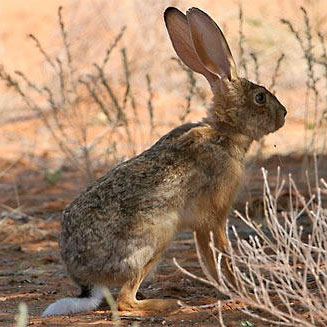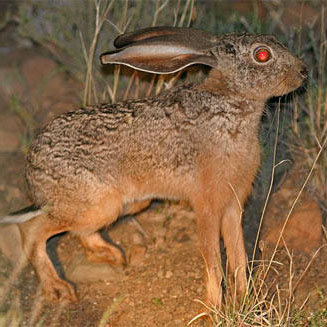|
Lepus capensis (Cape
hare)
vlakhaas [Afrikaans]; Kaphase [German]; ličvre du Cap [French];
sungura [Swahili]; umvundla [isiNdebele] [isiXhosa]; unogwaja [isiZulu];
mofuli [Sesotho];
matshwaratsela [na]; mmutla wamatshwaratselana, matsaatsela, mmutla wamatsaatsela, mmutlę
wamatsaatsela, ditshętlhane, moduô1ô [Setswana]; tsuro [Shona]; logwatja [siSwati]; mpfundla [Xitsonga];
muvhuda, khomu [Tshivenda]; shakame [Lozi];
unshuru [Yei];
!Ôas [Nama, Damara]
Life
>
Eukaryotes >
Opisthokonta >
Metazoa (animals) > Bilateria > Deuterostomia >
Chordata > Craniata > Vertebrata (vertebrates) >
Gnathostomata (jawed vertebrates) > Teleostomi (teleost
fish) > Osteichthyes (bony fish) > Class:
Sarcopterygii (lobe-finned fish) > Stegocephalia
(terrestrial vertebrates) > Reptiliomorpha > Amniota >
Synapsida (mammal-like reptiles) > Therapsida > Theriodontia
> Cynodontia > Mammalia (mammals)
> Placentalia (placental mammals) >
Euarchontaglires > Glires > Lagomorpha (rabbits, hares and
pikas) > Family: Leporidae (rabbits, hares)
 |
 |
|
Lepus capensis (Cape
hare), Tswalu Kalahari Reserve, South Africa Tswalu Kalahari Reserve, South
Africa. [photo Trevor
Hardaker ©] |
Lepus capensis (Cape
hare), Karoo National Park, Western Cape. [photo Trevor
Hardaker ©] |
Identification
Cape hares have a typical hare-like body shape
with long ears, long well-developed hind legs, a short fluffy tail
and a characteristic hopping gait. The body hair is fine and soft,
the upperparts vary in colour from light brown and black flecked, to
a whitish-grey in the north. Their colouration is so variable that
it is difficult to give a precise description. The belly is white.
The head is a lighter yellowish colour on the nose and the cheeks.
Most animals have a distinct white patch on the forehead just above
the eyes. The nucal patch, situated in the nape of the neck behind
the ears is a more brownish-pink colour than the rest of the body.
Northern animals are paler in colour with more grey, rather than
brown tones. The tail is black above and white underneath. The
females are larger and heavier than the males.
Size
Body length 45-60 cm; weight range 1.4 –2.5 kg
Dental formula
I C C P P M M =
26-28 =
26-28
Distribution and habitat
Wide distribution in the western and central
regions of South Africa. Isolated populations occur in Botswana,
Limpopo and southern Mozambique. Although widely distributed, the
original specimen from which Linnaeus described the species (called
a type specimen) came from the Cape of Good Hope. Prefers dry, open
habitats.
General Behaviour
Cape hares occur singly unless a female is
accompanied by courting males or her off-spring. They are nocturnal
but may be active during the early morning and the late afternoon.
During the day they lie up in “forms” (shallow depressions in the
ground or grass), usually concealed under bushes amongst some grass.
The drab colour of the body provides good camouflage and they fold
their ears flat back against their body with the head tucked in
against the body. Characteristically of hares when threatened they
remain motionless until the last second and then suddenly break
cover and rely on their speed to escape. If caught they emit a loud
squealing sound, and will kick viciously with their large back feet
and bite if given the opportunity.
Food
The diet of scrub hares consists of the leaves,
rhizomes and stems of dry and green grass, but they have a
preference for green grass. Coprophagy, the reingestion of fecal
material, is a common behavior amongst rabbits and hares. This habit
allows the animal to extract the maximum nourishment from fibrous
plant food and microbes present in the pellets also provide
nutrients. Two types of faecal pellets are produced soft moist
pellets often with a mucous capsule, and hard fibrous ones that are
discarded. Young hares consume these moist pellets produced by their
mother, this serves to introduce the necessary “flora” into the
digestive system of the young hare.
Predators, parasites and commensals
They have many natural predators including birds of prey,
caracal and
jackal.
Reproduction
After a gestation period of 42 days, females
give birth to 1-3 “leverets” per litter and may have as many as 4
litters per year. At birth the leverets eyes are open, they are
fully haired and can move around soon afterwards. The birth of young
at an advanced state of development is another characteristic that
separates hares from rabbits, that produce naked, blind babies in a
burrow. The leverets' cryptic colouration provides good camouflage,
and they are adept at concealing themselves. When they are very
young they appear to have no body scent as they are often passed
over undetected by dogs. .
Life span
1-2 years.
Conservation
Although Cape Hare numbers may be low in
certain areas due to hunting pressures and loss of habitat to
farming and urban development, they are not regarded as threatened
and their conservation status is graded as lower risk.
Text by Denise Hamerton |
